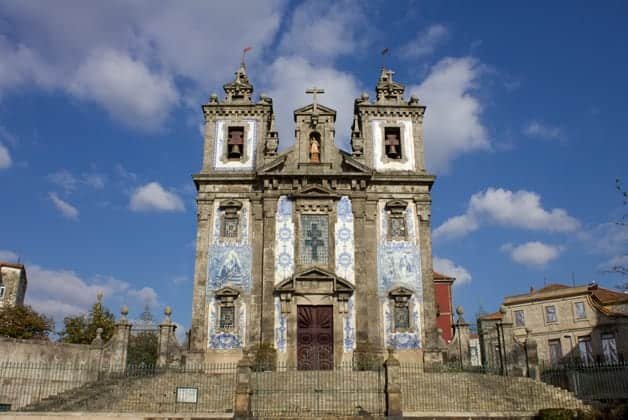We remain in the center of Porto but are now further away from the Douro River and Ribeira. Let's talk this time about the area between the southern part of Avenida dos Aliados, Santa Catarina and Mercado do Bolhão. This will be, in general terms, the third area in the center of Porto with monuments and historical buildings.
At the end of Praça da Liberdade and the beginning of Rua de Sá da Bandeira, there is a church that deserves my attention. Perhaps it is not the best known in Porto, but this 18th century church does not go unnoticed by visitors because of its eleven thousand tiles designed by Jorge Colaço. A Church of Santo António dos Congregados It has a baroque façade and the entire façade is dedicated to Saint Anthony where there is a niche with the image of Saint Anthony, who is also represented on the exterior tiles and in many paintings inside the church with scenes from his life. Entry is free.

We crossed the street and soon came across a huge, somewhat austere building. São Bento Station has straight lines and from the outside there is nothing that stands out, in fact, but it is on the inside that it shines. We enter and we only have time to marvel and gape. There are tiles everywhere we turn and the panel of twenty thousand tiles designed by Jorge Colaço leaves no one indifferent. They portray transport and various episodes in the history and ethnography of Portugal. It's really worth going in and seeing this 1916 station, especially because who knows, you might need to use it because trains still leave for Minho, Douro and Aveiro.



Let's now go up Rua 31 de Janeiro because we want to get to Praça de São João and the theater that bears the same name. O São João National Theater it was opened in 1920 and is a building with a classical structure, although it does not have a defined style. There are guided tours of its beautiful interior at 12:30 pm and cost €5. But what I want to highlight in this square full of cafes is higher up: the Church of Santo Ildefonso. This church is photographed many times and is worthy of a postcard because it is impossible not to resist its eleven thousand tiles that cover the facade and sides of the bell towers. The long staircase at the front opens the way to the interior with eight stained glass windows and a rococo altarpiece from the first half of the 18th century by Nicolau Nasoni. Entry is free so be sure to visit.

We now go up Rua de Santa Catarina and arrive at one of the most commercial areas in Porto. There are shops everywhere, but one that stands out the most is precisely a café: the famous Majestic. Opened in 1921 with the name Elite, later changed to the name Majestic, although it has maintained its beauty over time, which has served as inspiration for many political and cultural gatherings. This cafe is an example of architecture Art Nouveau and perfect for revisiting the period Belle Epoque, whose interior has lots of velvet, varnished wood, mirrors, carved ceilings, porcelain and lamps. It has a refined atmosphere so go there for a coffee and travel back in time.

If you continue going up Rua de Santa Catarina you will reach Via Catarina – a shopping mall where you can find the country’s main brands. But now we want to turn onto Rua Formosa towards the Bolhão Market. Before getting there we still got lost looking at the facade of the Pearl of Bolhão, a century-old house founded in 1917 and selling fine grocery products. The tiles advertise teas and coffees at the top of the facade and the entrance door is flanked by two panels that allude to the spice route.

But it's all so close that we quickly reach the Bolhão Market. It occupies an entire block (br: block) and is very emblematic in the city of Porto for the entire commercial environment that surrounds it, but especially for the market itself. The building dates back to 1917 and is a mix of concrete with metal structures, wooden roof and granite stonework. Go all the way around the market and get lost inside to feel the atmosphere. Before going down Rua Sá da Bandeira, we just make a small detour onto Rua Formosa and take a look at the Bolhão Confectionery (or we eat something if necessary), we continue until we see the Sá da Bandeira Theater It is The Brazilian, a new concept that reopened in March 2018 and combines a cafe during the day, a bar at night, a restaurant and a hotel. All in the same building. We now sit down to drink a coffee and recharge our batteries at the same point where we started in this area of Porto, which is very busy, with lots of emblematic stores in the city that you can't miss.